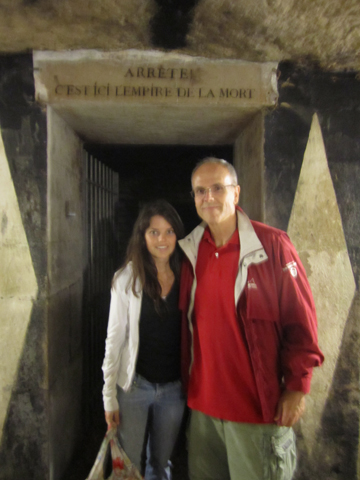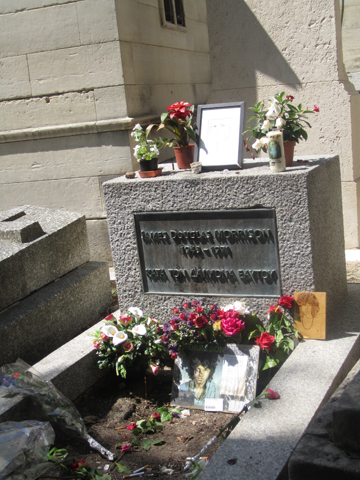We are staying just down the street from the Pere Lachaise Cemetery, our first week in Paris.
I had never been there, not being a big fan of cemeteries, even one often declared “the most famous cemetery in the world.” But it was only a mile or so away …
And … Paris also has some fairly famous catacombs which in part have been turned into an ossuary for the bones of hundreds of thousands of Parisians who died before 1786.
So, Britt and I decided, after Leah and Drew demurred, to turn this into our own Day of the Dead. Paris-style. The cemetery and the catacombs in the same day!
Pere Lachaise is laid out on a hilly spot that was outside the Paris municipal limits when it was created by Napoleon in 1804.
It would be a wonderful park, and still somehow is, if not for being jammed by crypts.
Some are crumbling and decrepit, with doors missing or left open. You can’t help but stare inside, looking for remains … and not seeing any.
Some are boring slabs, others are much more ornate. One looks like a mini Parthenon.
What makes Pere Lachaise famous are its permanent residents. Most of them French artists or thinkers such as Edith Piaf, Balzac, Sarah Bernhardt, Bizet, Moliere, Pissarro, Proust … and a few random foreigners, including Oscar Wilde, Rossini and the mercurial U.S. and Confederate politician Judah P. Benjamin.
But the most famous of all of Pere Lachaise’s inmates, at least for the past three decades, seems to be Jim Morrison, lead singer of The Doors, who were big in the late 1960s. Morrison is now as famous for being famously dead of, apparently, a drug overdose in a Paris bathtub in 1971, at the age of 27, as he was for his music.
So, yes, we went directly to Morrison’s grave, below, and we knew we were close when we saw the little crowd gathered around the fairly simple grave. As always (apparently), it had flowers on it, and pictures of the troubled singer were propped up and around it …
Britt wasn’t entirely clear who Jim Morrison is/was, which makes sense, but many of the people around the gravesite were born after he died. So. Hmmm. We considered looking at Edith Piaf‘s grave, a troubled pop star of an earlier era, but The Sparrow is buried in the northeast corner of the cemetery, and we weren’t going to make the hike. Desolee, Edith.
Over to the metro, down the 2 line to Nation, a change of trains to the 6, and 13 stops later we were at Denfert-Rochereau, the southern entry into the city 200 years ago. We climbed up to the street, looked across the way, and there was the entrance for …
We had read up on this enough to know that authorities allow only 200 people at a time down the stairs … and the line was about 200 people long when we walked up. We were told we could not be guaranteed access to the catacombs before 4 p.m., when the last people are allowed to enter, but we stuck it out, along with the rest of an eclectic crowd which involved lots of Goths and quite a few kids under 13. Hmm, again.
We made it to the entrance at 3:45 (and read the notice advising against entry for people with heart or breathing problems, or nervous conditions), and after handing over 12 euros we descended the 100-plus steps in the poorly lit and narrow circular stairway … and tried to remember what about any of this had ever seemed like a good idea.
Visitors have to walk at least a quarter of a mile through the narrow and twisting passages before they see anything more interesting than the marks left on the walls by the guys who had quarried stone for building out of these holes 250 years ago. This walk without seeing anything seems to heighten the ewww! factor by a multiple of 10. Your imagination begins to get the better of you.
Just before visitors finally get to the bones, they pass by photos of partly decomposed bodies (why?) and see the door frame that leads to the ossuary, a frame that is topped by a sign that reads: Arrete, c’est ici l’empire de la mort (Stop, this is the empire of the dead) … a nice touch vaguely reminiscent of the “Abandon hope all ye who enter here” from Dante’s Inferno — which Disneyland appropriated for its “Pirates of the Caribbean” ride.
Through the door … are bones. Mounds and mounds of bones, stacked to the height of a living man. On both sides of the passageway.
Yes, it’s creepy to see all those empty eye sockets looking back at you. And you can’t help but think “all of those were living people … and perhaps some day other living people will be looking at us.”
If you didn’t follow the link to the catacombs, above, the bones come from all the cemeteries in the center of Paris that were banned, for health reasons, in 1786 and ordered transferred to the abandoned quarries just outside the city gates. It took decades to accomplish it, but workers collected all the skeletons from all those cemeteries … and rolled them to the catacombs and somehow carried them down.
Apparently, they were stacked/piled haphazardly for a while, and then a French official decided they should be arranged “artistically” … an interesting concept in itself.
Each mound is a little different (and most are labeled with the name of the cemetery from which those bones came) … but the typical mound looks something like this: a batch of long bones (femurs, mostly, it seems) stacked from the floor up a few feet, and then a line of skulls, followed by more stacked long bones, another row of skulls, more stacked long bones and then skulls across the top. With some smaller, narrower bones (tibias, etc.) piled up behind.
(Can you imagine the guys who were paid to do this for however long it took? “Well, I’m off to stack some bones. See you for dinner.”)
Two disquieting aspects of the ossuary: the cavern leaks. Water drips from the roof in several areas, and collects on the smooth stone floor and sometimes makes it a bit slippery. The idea of the water dripping on you is not an attractive one. As Britt put it, “I don’t want bone water on me.” Can’t say I disagreed with that. And the other skin-crawling moment comes at the end of the 90-step climb up ultra-narrow circular stairs … when a guy working for the government asks to check your bag. Exactly. So that you don’t sneak out with bones you pulled from the mounds. Ack.
Back out into the Paris air, and you wonder 1) if people who live up here realize that the remains of perhaps millions of people are about 25 yards below them and 2) if the Paris government chuckles at the idea of gaining thousands of euros per day from people who just want to look at bones. Talk about an attraction with minimal upkeep …
A bit morbid. For sure. And perhaps a good advertisement for cremation, because if you leave behind bones you could end up in a museum or an ossuary or inside a broken down crypt in a cemetery, and do you really want that?
But it seemed like Something Everyone Who Goes to Paris Needs to Do. And Britt and I did it. Though we didn’t do it on Friday the 13th. And I don’t imagine we will want to do it again, any day of the week.



1 response so far ↓
1 Gil Hulse // Aug 12, 2010 at 11:31 AM
I heard, read, whatever that there are folks who find unauthorized entrances to the catacombs and go off into the far reaches. Now that you’re experienced, think you should go for it.
Leave a Comment